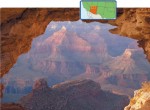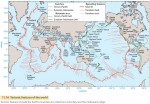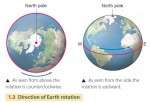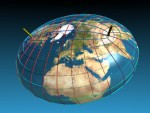Geosight #1: The aurora
Although aurorae are visible far from the polar regions (real biggies have been seen in distinctly unpolar spots such as Hawaii), places such as Scandinavia, southern New Zealand and Alaska are favoured for viewing them. But don't go too far north or south. The region inside the annulus is rather poor as an aurora-watching zone. […]
The tides
While the Sun gives out the heat and light that makes life on Earth possible, it also contains almost all the mass in the solar system, which means that it has almost all of the gravitational pull. This keeps the Earth in its orbit, but that is not the whole story. Set loose on the rotating […]
Varves
How do we know that there were over 420 days a year, 600 million years ago? By counting. You only need walk in the woods from time to time to know that trees like the summer more than the winter. They grow faster when it is warmer and therefore their age can be determined by […]
Biggest bores
It's a little like the breezy way people say'Hoover” when they mean “vacuum cleaner”. Most people who think about tidal bores in rivers think about the Severn Bore. It is seen at its highest, with a good one being over 2m high, in Gloucestershire. But there are plenty of others. On the I rent in […]

Top tides
Various points in the Bay of Fundy, Canada, claim to have the world's highest tides. This undignified squabble is mostly about dragging in tourists. My favourite river, the Mersey in England, has a tidal range of about 4m, which is pretty spectacular. Anywhere in Fundy has a range of over 12m, which would be a […]

Sunspot variation
Have you ever seen those old prints of happy Londoners holding “frost fairs” on the frozen Thames? The fairs were held when the Thames flowing through London froze hard enough for people to move onto the ice for weeks at a time. The earliest seems to have been in 1434. In the 1660s, ice skating […]

Longer-term climatic cycles
In addition to the annual cycle of the seasons, there are longer-term cycles at play which affect the amount of energy the Earth receives from the Sun, causing significant variations in the Earths climate. First, there have now been almost 400 years of routine observations of the Sun which show that sunspots appear on its surface […]
The Earth in space: The seasons
From our point of view, the Suns main purpose is to keep us warm. The Earth receives energy from the Sun at a rate of about 340 watts for every square metre of its surface, mostly in the form of heat or light. Of this energy, 30 percent is reflected away at once, and the […]
Kepler’s laws of planetary motion
Johannes Kepler set out his first and second laws of planetary motion in 1609 and the third in 1618. The first states that the orbit of a planet is an ellipse with the Sun at one of its foci. The foci of an ellipse are hard to define but easy to show with a nursery […]
Dividing up the globe
Four imaginary lines help describe how the Sun's position in the sky varies according to your latitude. The Tropic of Cancer and the Tropic of Capricorn are lines – 235° north and south of the Equator – between which the Sun will be vertically overhead at some point in the year.They get their names because […]
Is the Earth the only planet to harbour life?
Pending the results of any expedition beneath Europas icy exterior, and of investigations into the possibility of life on Mars the Earth is currently the only planet that we know houses life. This seems obvious if you glance about the solar system, where everything you see is too hot, too cold, too poisonous or in some […]

Mars as the abode of life
Mars As The Abode Of Life was the title of a book published in 1908 by Percival Lowell. He was convinced that the canals of Mars were proof positive of the existence of an advanced civilization that had built a planet-wide irrigation system to ship water from the polar ice-caps to the Equator. At the […]
Earth cousins
How unique is the Earth in its structure and composition? Our knowledge of the other planets in our solar system has been increasing apace in recent times. As the astronomer Carl Sagan (1934-96) put it, we are the generation in whose lifetime the planets of the solar system have turned from being ill-seen lights in […]
Venus, the Earth’s unlucky twin
Venus is 12,100km across, 95 percent the diameter of the Earth. It has 82 percent of its mass, 90 percent of its surface area, 90 percent of its surface gravity… You get the idea. It even seems to have a core, mantle and crust much like the Earth's, although its feeble magnetism rules out a […]
How old is the Earth?
There is no direct way to find out the age of the Earth. In the modern era, the predictably steady decay of radioactive material in rocks allows them to be dated. But even that is little help here. The Earth is so geologically active that it has no rocks lying around from the time of […]
The Earth beneath our feet
Now that we've charted its origins, let's take a look at planet Earth in a little more detail. The centre of the Earth is a chunk of hard metal, mostly iron, called the inner core. It has a radius of about 1200km; as is often pointed out, that is about the size of the Moon. […]
Planet Earth: In the beginning…
So where did the Earth and all its fellow planets come from? In the beginning, the universe and all the matter in it essentially sprang from absolutely nothing, a minute “singularity” which erupted in a “big bang” to produce the expanding universe we see today. All this happened 14 billion years ago, and this was […]

How the Moon was made
There is one satellite that does not need me to tell you who discovered it, because at an early age, you discovered it for yourself. The Moon has been recorded – to begin with, in carvings on animal bone – for over 20,000 years. It affects our lives in too many ways to describe, and […]
The one that didn’t make it
Not all the matter in the solar system has been swept into the Sun or the planets. There are many other objects out there, such as comets, meteorites and asteroids, although their combined mass is trivial, less than half the mass of the Moon. In the main, these do not concern us here; however, there […]
Planet Earth: What is a planet?
The basic definition of a planet is simple enough. A planet is too small and cool to be a star, but massive enough to form a solid globe. Many, such as the big outer planets of our solar system, hide this solid surface beneath a dense atmosphere. All the planets we know are in orbit […]
The dullest debate in science
“I have found your Planet X” said Clyde Tombaugh to Vesto Slipher on 18 February 1930. Tombaugh was a humble observer, while Slipher was a top astronomer, and Tombaugh's boss at the Lowell Observatory in Arizona. But finding Pluto put Tombaugh into the record books and ensured that he is probably better known today than […]
Flat Earth?
Portuguese explorer Ferdinand Magellan (1480-1521) led the first expedition to circumnavigate the Earth (although he died on the journey). He said he knew the Earth was round because he had seen its shadow on the Moon, during a lunar eclipse. He added that although the Church said the Earth was flat, he would rather trust […]

External Forces Shaping the Earth
A HUMAN PERSPECTIVE In Egypt, a seasonal dry wind is called khamsin (“fifty”) for the number of days the season occurs. During khamsin, wind-driven sandstorms kill and injure people, close businesses and airports, and strip topsoil and seed from the ground. Sandstorms are not limited to the desert areas of Africa and Southwest Asia. For […]

Internal Forces Shaping the Earth
BASICSA HUMAN PERSPECTIVE Sally Ride, America's first female astronaut, wrote the following after one of her trips into space: I also became an instant believer in plate tectonics; India really is crashing into Asia, and Saudi Arabia and Egypt really are pulling apart, making the Red Sea even wider. Even though their respective motion is […]

The Earth Inside and Out
A HUMAN PERSPECTIVE A quick look at a world map will convince you that the continents, landmasses above water on earth, fit together like a huge jigsaw puzzle. South America and Africa are good examples. With imagination, you can see how other continents might fit together as well. The first person to suggest that the […]

Major Relief Features of the Earth’s Surface
THE LITHOSPHERE AND ASTHENOSPHERE The major relief features of the Earth—its continents and ocean basins—were created by the movements of plates on the surface of the Earth. Geologists use the term lithosphere to describe an outer Earth shell of rigid, brittle rock, including the crust and also the cooler, upper part of the mantle (Figure 11.15). The lithosphere ranges in thickness […]

Minerals and Rocks of the Earth’s Crust
What lies deep within the Earth? Our planet has a central core with several layers, or shells, surrounding it. The densest matter is at the center, and each layer above it is increasingly less dense. THE EARTH'S INTERIOR Our planet is almost spherical, with a radius of approximately 6400 km (about 4000 mi). Its central core is about 3500 km […]

CERES—Clouds and the Earth’s Radiant Energy System
The Earth's global radiation balance is the primary determinant of long-term surface temperature, which is of great importance to life on Earth. Because this balance can be affected by human activities, such as converting forests to pasturelands or releasing greenhouse gases into the atmosphere, it is important to monitor the Earth's radiation budget over time as accurately as possible. For nearly 20 years, NASA has studied the […]

The Earth’s Revolution around the Sun
So far, we have discussed the importance of the Earth's rotation on its axis. But what about the Earth's movement as it orbits the Sun? We refer to this motion as the Earth's revolution around the Sun. The Earth takes 365.242 days to travel around the Sun—almost a quarter of a day longer than the calendar year of 365 days. […]

Earth Rotation
The Earth spins slowly on its axis —an imaginary straight line through its center and poles—a motion we refer to as rotation. We define a solar day by one complete rotation, and for centuries we have chosen to divide the solar day into exactly 24 hours. The North and South Poles are defined as the two points on the Earth's […]

The Shape of the Earth
As we all learn early in school, the Earth's shape is very close to a sphere. Pictures taken from space by astronauts and by orbiting satellites also show us that the Earth is a ball rotating in space. Today it seems almost nonsensical that many of our ancestors thought the world was flat. But to ancient sailors voyaging across the […]
Earth Visualization Tools
Within the last few years, remote sensing, geographic information systems, and GPS technology have been integrated into new and exciting Internet tools for visualizing the Earth. Google Earth and World Wind are outstanding examples of these Earth visualization tools. GOOGLE EARTH Google Earth is a program for personal computers that allows users to roam the Earth's surface at will and zoom […]

rotation, Earth axis
EARTH HAS TWO primary motions: revolution and rotation. The first refers to the earth's annual orbit of the sun, which takes a bit more than 365 days per year (hence, a leap year with 366 days every four years in order to “catch up”). As it revolves around the sun, the Earth rotates on its axis once every 24 hours, […]

Nap of the Earth
NAP OF THE EARTH, or NOE, is a Vietnam War-era term for very low-level flight, particularly of helicopters. The concept behind this type of flying is that a pilot guides his or her craft as close to the Earth's surface as terrain, vegetation, and other obstructions will allow and maintains that low altitude while approaching […]